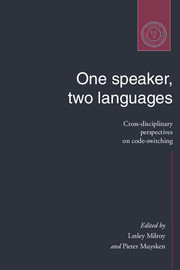Book contents
- Frontmatter
- Contents
- Notes on contributors
- Acknowledgments
- 1 Introduction: code-switching and bilingualism research
- Part one Code-switching in institutional and community settings
- 2 Bilingual speech of migrant people
- 3 Code-switching in the context of dialect/standard language relations
- 4 Code-switching in community, regional and national repertoires: the myth of the discreteness of linguistic systems
- 5 Code-switching in the classroom: two decades of research
- Part two Code-switching and social life
- Part three Grammatical constraints on code-switching
- Part four Code-switching in bilingual development and processing
- Index
3 - Code-switching in the context of dialect/standard language relations
Published online by Cambridge University Press: 05 June 2012
- Frontmatter
- Contents
- Notes on contributors
- Acknowledgments
- 1 Introduction: code-switching and bilingualism research
- Part one Code-switching in institutional and community settings
- 2 Bilingual speech of migrant people
- 3 Code-switching in the context of dialect/standard language relations
- 4 Code-switching in community, regional and national repertoires: the myth of the discreteness of linguistic systems
- 5 Code-switching in the classroom: two decades of research
- Part two Code-switching and social life
- Part three Grammatical constraints on code-switching
- Part four Code-switching in bilingual development and processing
- Index
Summary
On principles and conditions underlying code-switching
In the current state of language-contact research, code-switching (CS) studies have been mainly concerned with clearly separated, often typologically distant, pairs of languages. One question that has been insufficiently explored is whether both syntactic models and pragmatic functional models which are intended to account for code-switching patterns can straightforwardly be applied to situations where the languages in contact are the standard language and a genetically related dialect. It is reasonable to assume that conditions and constraints may be shaped differently depending on different contact situations. This could lead us to claim that different models of CS can be selected heuristically on the basis of types of contact situations to be accounted for.
As a case in point, I shall focus on the Italian situation because I assume that investigating this specific situation might provide us with broader insights into a range of comparable cases. So far, contact phenomena in Italy have attracted the attention of traditional dialectologists interested in the process of italianisation of dialects or, conversely, in the influence of dialects on Regional Italian. Indeed, switching behaviour between Italian and dialects has scarcely been investigated, either empirically or theoretically.
The structure of this chapter is as follows: I will first discuss some general issues by relating them to the Italian situation (section 1), and will later describe at some length the presence and uses of varieties in the Italian repertoire (section 2).
- Type
- Chapter
- Information
- One Speaker, Two LanguagesCross-Disciplinary Perspectives on Code-Switching, pp. 45 - 67Publisher: Cambridge University PressPrint publication year: 1995
- 21
- Cited by



